It can be daunting to learn how to set up a sugar glider cage, but it’s extremely easy! You just need to know what do sugar gliders need in their cage, what habitat requirements they need, and you’re all set!
Learning how to set up a sugar glider cage could be tough, especially if you’re not familiar with it.
So, in this guide, I’ll be going deep into the topic, and discuss everything you need to know in setting it up!
In anticipation of that, though, what’s the size requirement for a sugar glider cage?
Table of Contents
How Big Should a Sugar Glider Cage Be?
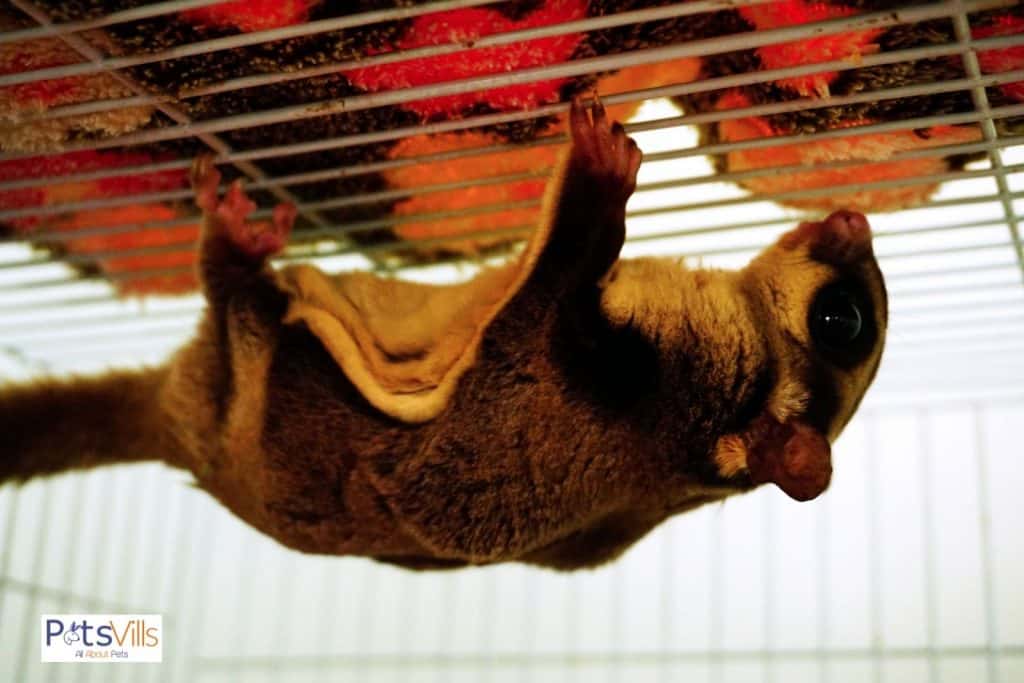
Knowing the cage size requirement will be difficult. In my first attempt, I even thought a small bird cage is enough, and apparently, it isn’t.
So, in choosing the dimensions of your cage and the bar spacing involved, you must consider the following:
- Size of your sugar gliders
- Number of sugar gliders that would share the habitat
As experts suggest [1], the recommended cage size for one (1) sugar glider is 20” x 20” x 30”. If you’ll accommodate two (2), you simply have to double up on the size.
Bar Spacing of the Cage
When it comes to the bars, they should be tight and close enough that your pet can’t squeeze through. These little dynamos are flexible creatures and if at first glance you think they wouldn’t fit, they would!
The recommendation by many experts would be bar spacing that’s not ½ inches wide. [2]
Before learning how to set one up, let us first try to enumerate the things your furry friends need in their cages.
What Do Sugar Gliders Need in Their Cage?
Sugar gliders need toys to beat boredom, equipment for feeding, and of course, the relaxation pods in their cages. During my first experience setting one up, I had no idea where to start.
Sugar gliders are social animals –they’re also active creatures. So, keeping their cage lively and fun would be the right thing to do.
But before injecting the “fun” in the formula, what do sugar gliders need in their habitat?
Nest Boxes or Nest Pouches
Imagine being at home without a bed, what would you feel? Your furry friends will feel the same way, too! One of the most important things you need to put in their cages would be the nest box. It’s their haven for the times they want to relax.
NOTE: You can substitute nest boxes for nest pouches if you prefer them hanging instead of them being on the base of the cage.
Water Bottle or Water Dishes
Water bottles are also important to keep inside the cage. Keeping one is as important as providing food dishes or a container for the food that you’ll feed them.
NOTE: At first, your pet gliders may not know how to drink from a water bottle. So, try adding a water dish instead. They will eventually learn how to use water bottles, so don’t worry.
Bird Toys
Sugar gliders, as we know them, are interactive and social animals. They love playing with things they can get their tiny hands on.
Make sure you add toys for sugar gliders, which can be bird toys, toddler’s toys, and an assortment of toys you think would be effective.
Exercise Wheels
Apart from animal toys, it would also be great to add exercise wheels.
It’s another form of a toy in their minds, but for us, it’s for them to keep those legs and joints healthy. You could install exercise wheels that hamsters and other rodents use inside their cages.
Food Dishes
Last, but most definitely not least would be food dishes. This is the part of the cage they’ll be looking forward to every hour of every day. You can purchase food dishes for hamsters or for birds, any would do.
NOTE: Make sure that the food dish you’ll place is a few inches wider than their heads. This will help them avoid being stuck in between the bars of the cage.
Now that you know the most important things to put in the cage, how do you set it up? What parts do you establish and put up first?
How to Set Up a Sugar Glider Cage? [Complete Guide]
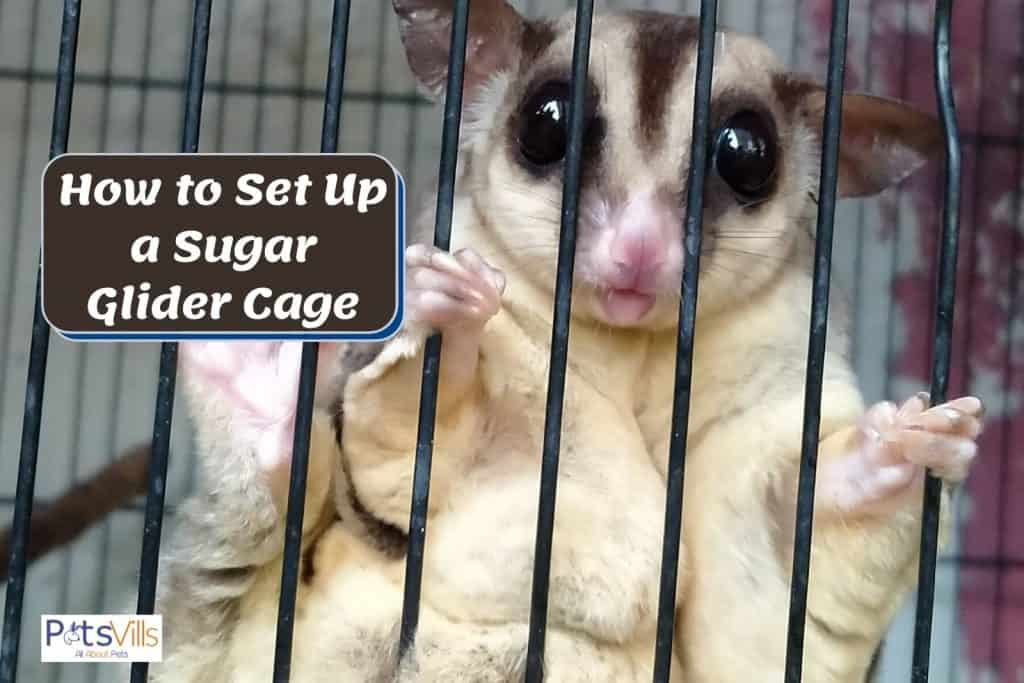
When I set up my first ever cage, I didn’t know where to start and what to do.
So, I went on and just placed it in my room, threw in a food dish and a water bottle, and a small sleeping pouch for my furry friend.
A few hours later, the relentless hissing and barking sounds appeared. It was then that I realized that they’re active social animals and they need something to do, too!
So, here’s a foolproof way to set up and keep your furry friends’ habitats perfect for them.
Step 1: Choose the Right Cage for Your Sugar Gliders
The number one consideration you need to have in choosing their habitat would be the size. Cage sizes will vary depending on the number of sugar gliders you have. Of course, the more sugar gliders you’re accommodating, the larger cage needs to be.
Try checking finch cages and bird cages; check on the available sizes, too. Then, carefully pick the one that has considerate bar spacing that would keep your furry friends from getting out without you knowing.
Step 2: Find the Perfect Spot for Your Cage
The next thing you want to do is to find a good location where you will be putting the cage. Experts recommend placing the cage at a spot that’s easily accessible and is out of direct sunlight. [3]
Moreover, you want your pet glider cage to be installed at a location that’s safe. The location should be:
- Free from drafts and debris
- At a constant temperature of 18 to 24 degrees Celsius (65 to 75 degrees Fahrenheit)
- Far from entryways of your home like doors, windows, and exhausts
NOTE: You can install caster wheels on your sugar glider cage so it’s mobile and not just kept at a single location.
Step 3: Gather the Needed Things for the Cage
After that, gather everything listed above. Yes, everything – including those poop trays! Don’t install and place them inside the cage yet, as you need to plan it out first.
So, prepare everything, from the nest pouches or nest boxes, the bedding material, to the toys, exercise wheels, ropes, food dishes, water bottles/water dishes, bedding/lining, and pull-out dropping trays.
NOTE: Store them at a place where you’ll be able to see them all. This is for you not to panic when you’re about to install them.
Step 4: Set Up the Nest Box/Nest Pouch
Then, the next thing to do is to start installing their sleeping pods – the nest boxes pouches. Don’t confuse yourself too much about it; nest boxes can be as simple as plastic, wicker, and even untreated wood.
For nest pouches, it can be a sturdy cloth that you’ll hang from atop the cage.
And while it’s something not to stress on, it’s good to invest in these things, too. You never know when you’ll purchase another furry friend, so being prepared won’t hurt.
Placing the Nest Box
Placing the nest box in the cage is simple, you just have to position it across where you’ll be placing the pull-out tray. This will prevent them from accidentally eating their own wastes.
You can also position it adjacent to the water and food dishes for them to be able to access it easier.
Placing the Nest Pouch
On the other hand, you can hang your nest pouches anywhere in the cage. If you’ll install more than two (2) keep the distance moderate (not too far or near).
Furthermore, make sure that the pouches won’t entangle with one another if in case your friends decide to play around with them.
Step 5: Lay the Bedding Materials
Most sugar glider cages would be large finch or bird cages. Therefore, the base would be a wire bottom. To make sure that your pets wouldn’t make a mess, install the bedding material on the bottom or base.
This can be as simple as an absorbent substrate that would suck up liquid and catch solids that would be free-falling within the cage.
NOTE: If your cage already has pre-installed bedding, there’s no need for you to install one.
Step 6: Install the Pull-Out Droppings Tray
The “poop tray,” as we pet lovers call it, is an integral part of any type of cage. It is where all the waste will be collected.
The pull-out tray usually goes together with the bedding material. It’s a complementary addition to the cage. You can purchase a separate pull-out tray if the cage you bought doesn’t have one yet.
Mine didn’t have one so what I did was install the pull-out tray directly below the bottom of the cage.
Step 7: Add Bird Toys and Other Accessories
Lastly, add the toys and other accessories that would keep your pets occupied. You can do variations on the toys you’ll add. They can be as simple as leashes, open-ended pouches, chew toys, bells, sounding squeak toys, and many more!
Apart from regular toys, it would also be good to add other sources of activities. These include exercise wheels, ladders, ropes, swings, and soft cloth balls, too!
NOTE: Some experts recommend adding branches, stems, and other wood materials, too. This creates an atmosphere of familiarity with your pet.
Once done, you can now be carefree that your social animals will have a place to call home. You’ll know that you were properly able to set it up when you see them spending time, enjoying their vertical space.
You can also opt for a DIY sugar glider cage.
What Makes a Good Sugar Glider Cage?
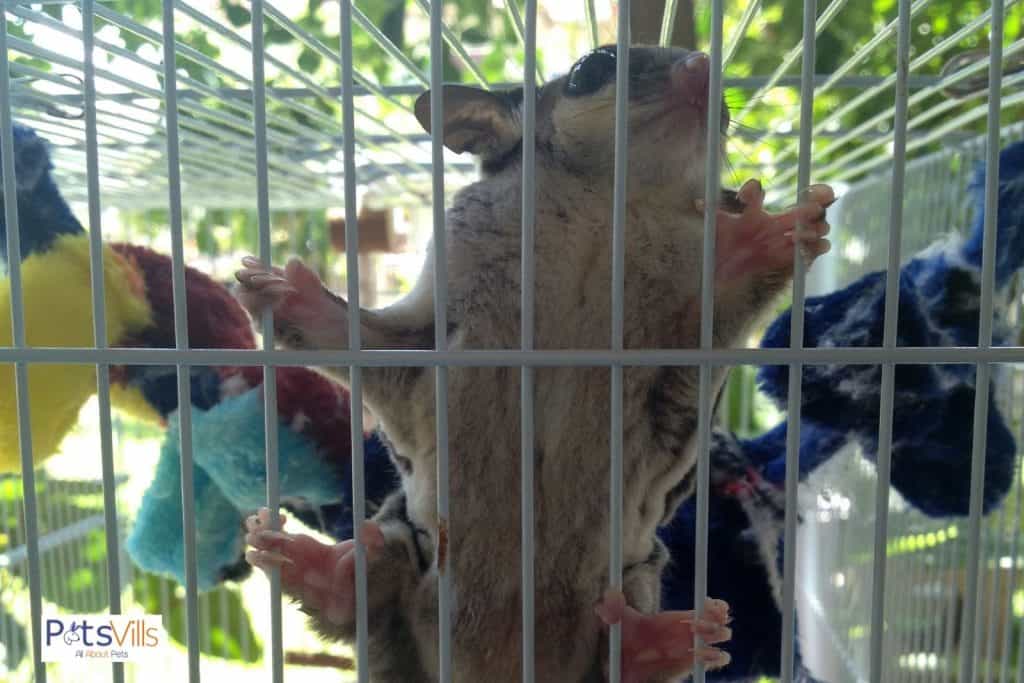
What many would consider a good sugar glider cage is the one that’s placed in the correct spot, as well as the one that contains everything their friends need. This would include:
- Animal Toys
- Cloth Balls & Ropes
- Nest Boxes or Nest Pouches
- Food Dishes
- Water Dishes
What baffles most first-time sugar glider owners is how they can make their pets’ habitats fun and amusing. And in considering the points above, you can most definitely say that your sugar glider cage is different, in a positive way.
Check: How to Clean Sugar Glider Cage
FAQs About How to Set Up a Sugar Glider Cage
Here are some of the most common questions about setting up a sugar glider cage.
Can I use a Hamster or a Rabbit Cage For My Sugar Glider?
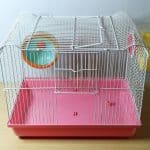
No, you can’t use a hamster or a rabbit cage to be your sugar glider cage. It’s simply because these are horizontal cages. Our pet sugar gliders need headspace for them to be able to climb, glide, and skim through their artificial habitat.
Do Sugar Gliders Need to Be Covered At Night?
No, they do not need to be covered at night. In fact, they cha-cha during the night. They’re nocturnal animals, meaning, most of their energy is spent at night (eating, socializing, exploring).
Do Sugar Gliders Need a Heat Lamp?
No, you wouldn’t need a heat lamp beside your sugar glider cage because experts recommend keeping the habitats of sugar gliders below 85 degrees Fahrenheit (29.4 degrees Celsius) [4].
What Kinds of Toys Do Sugar Gliders Like?
Sugar gliders love a variety of animal toys such as chew toys, squeaky toys, and fun balls. You can throw in heavy-duty ropes, ladders, exercise wheels, as well as stems and branches for them, too.
How Often Should You Clean Your Sugar Glider Cage?

The best and most ideal habit to develop is to clean the cages at least once (1) per week. This would include cleaning the bedding, taking some food from the toys, and removing the waste from the pull-out droppings tray.
NOTE: For the food dishes and water bottles/dishes, clean them daily and sterilize once every 60 days. Clean the cloth, pouches, and nests at least once per week.
Conclusion
If you find yourself troubled in the process of how to set up a sugar glider cage, you’re in for a treat!
I outlined everything you need to know about building or setting up a habitat for your furry friend in this guide, and you don’t need a separate source any longer!
References:
- 1. Beginner’s Guide to Sugar Glider Care – VetCare Pet Hospital [Internet]. VetCare Pet Hospital. 2016 [cited 2021 Dec 2]. Available from: https://www.vetcarepethospital.ca/beginners-guide-sugar-glider-care/
- 2. https://www.facebook.com/thespruceofficial. How to Set up a Home for Your Sugar Glider [Internet]. The Spruce Pets. 2019 [cited 2021 Dec 2]. Available from: https://www.thesprucepets.com/cages-for-sugar-gliders-1237336
- 3. Suggested Cage Requirements [Internet]. Exotic Nutrition. 2019 [cited 2021 Dec 2]. Available from: https://www.exoticnutrition.com/suggested-cage-requirements.aspx
- 4. Pocket Pets [Internet]. Pocket Pets. 2021 [cited 2021 Dec 2]. Available from: https://www.sugargliderinfo.org/pages/sugar-glider-cage-guide
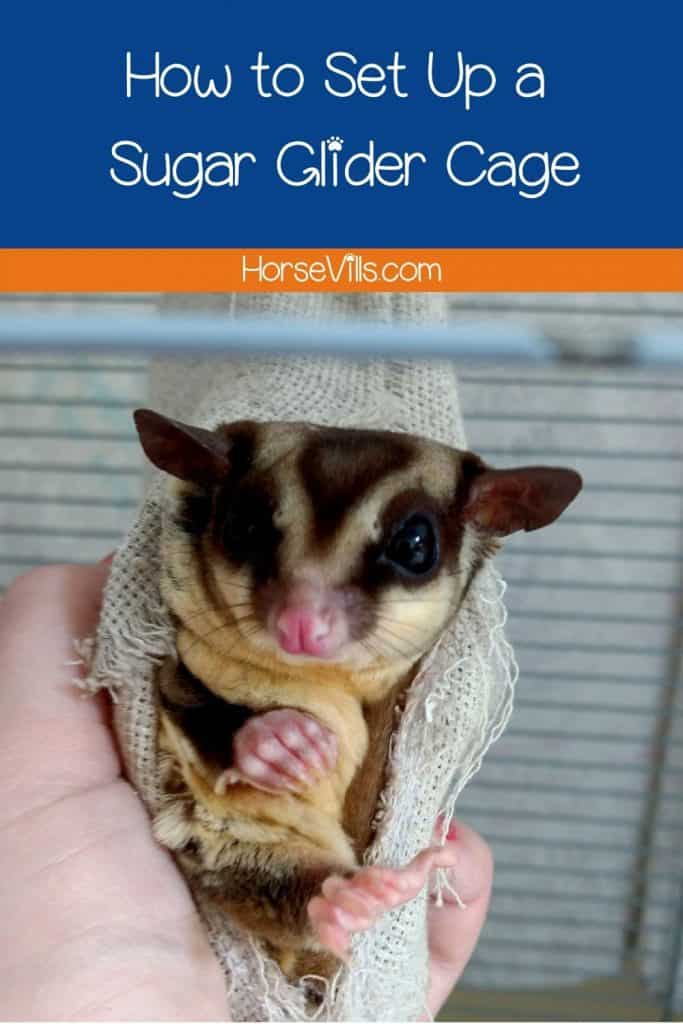
Do you have more tips on how to set up a sugar glider cage? Let us know in the comments below!
Barry Stingmore is a British content writer living in Fuerteventura, Spain. An animal lover at heart, he shares his home with a dog and four rescue cats and has a passion for writing about animals big and small.
Barry loves finding answers to your animal-related questions, the more research involved the better! You can rely on him to find the facts.
Find him on FACEBOOK, TWITTER AND Linkedin
Read his latest ARTICLES.
Find more about him HERE.

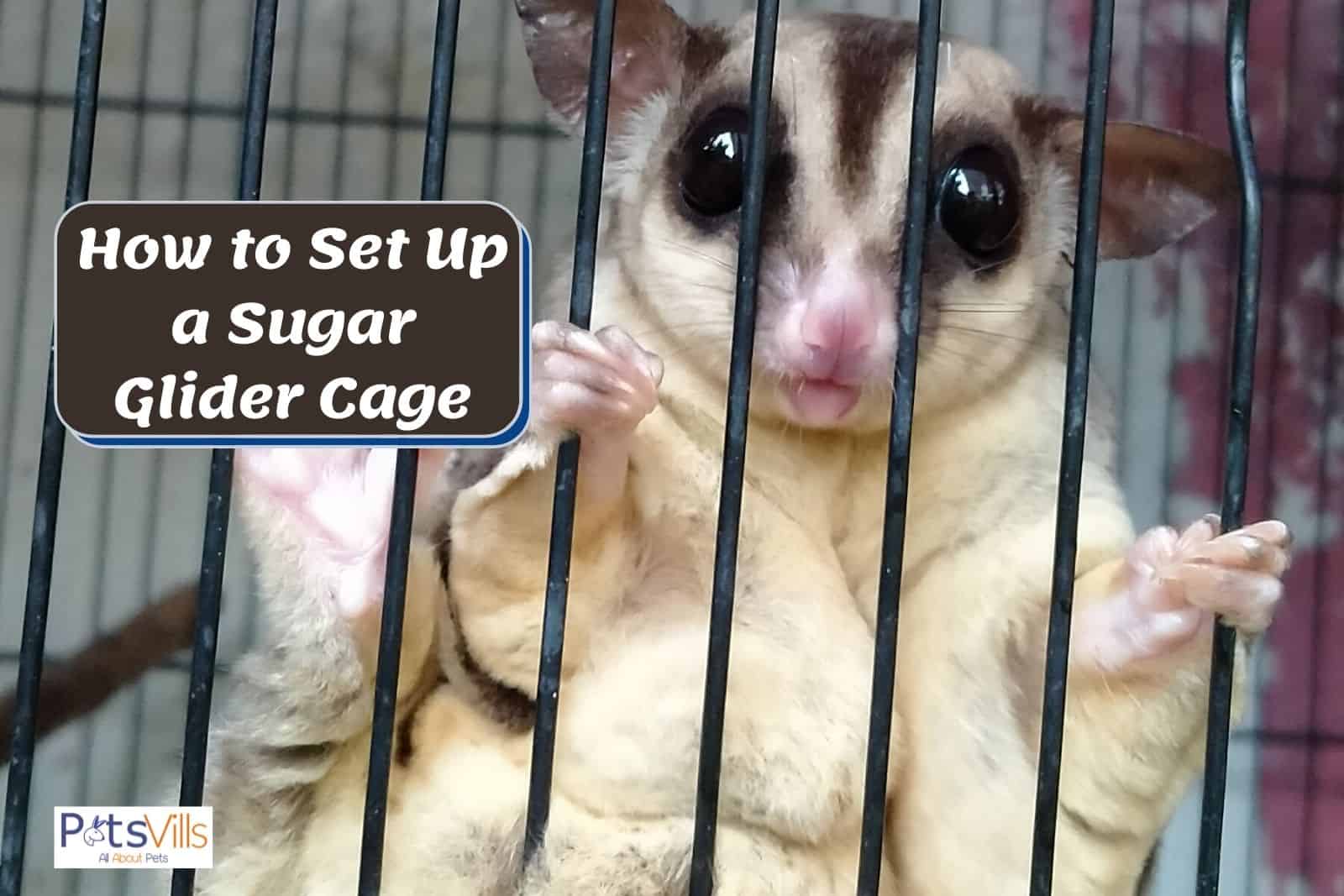


![Cute Sugar Glider Drinking From The Bottle [Must-Watch Video]](https://petsvills.com/wp-content/uploads/2022/09/Cute-Sugar-Glider-Drinking-From-The-Bottle-Must-Watch-Video-211x150.jpg)
